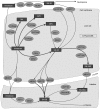Uridine 5'-diphospho-glucronosyltrasferase: Its role in pharmacogenomics and human disease
- PMID: 29896223
- PMCID: PMC5995049
- DOI: 10.3892/etm.2018.6184
Uridine 5'-diphospho-glucronosyltrasferase: Its role in pharmacogenomics and human disease
Abstract
Biotransformation is an enzyme-catalyzed process in which the body converts endogenous compounds, xenobiotics and toxic substances into harmless or easily excreted metabolites. The biotransformation reactions are classified as phase I and II reactions. Uridine 5'-diphospho (UDP)-glucuronosyltransferases (UGTs) are a superfamily of phase II enzymes which have roles in the conjugation of xenobiotics or endogenous compounds, including drugs and bilirubin, with glucuronic acid to make them easier to excrete. The method the human body uses to achieve glucuronidation may be affected by a large interindividual variation due to changes in the sequences of the genes encoding these enzymes. In the last five years, the study of the genetic variants of the UGTs at a molecular level has become important due to its association with several diseases and the ability to predict adverse events due to drug metabolism. In the present review, the structure and the prominent genetic variants of the UGT1A subfamily and their metabolic and clinical implications are described.
Keywords: UGT1A1*1; UGT1A1*28; pharmacogenomics; uridine 5′-diphospho-glucuronosyltransferases.
Figures


Similar articles
-
Pharmacogenomics of human uridine diphospho-glucuronosyltransferases and clinical implications.Clin Pharmacol Ther. 2014 Sep;96(3):324-39. doi: 10.1038/clpt.2014.126. Epub 2014 Jun 12. Clin Pharmacol Ther. 2014. PMID: 24922307
-
The Uridine diphosphate (UDP)-glycosyltransferases (UGTs) superfamily: the role in tumor cell metabolism.Front Oncol. 2023 Jan 19;12:1088458. doi: 10.3389/fonc.2022.1088458. eCollection 2022. Front Oncol. 2023. PMID: 36741721 Free PMC article. Review.
-
Genetic variation of human UDP-glucuronosyltransferase: implications in disease and drug glucuronidation.Am J Pharmacogenomics. 2003;3(1):37-52. doi: 10.2165/00129785-200303010-00006. Am J Pharmacogenomics. 2003. PMID: 12562215 Review.
-
Gender-dependent differences in uridine 5'-diphospho-glucuronosyltransferase have implications in metabolism and clearance of xenobiotics.Expert Opin Drug Metab Toxicol. 2013 Dec;9(12):1555-69. doi: 10.1517/17425255.2013.829040. Epub 2013 Sep 6. Expert Opin Drug Metab Toxicol. 2013. PMID: 24011176 Review.
-
Human UDP-glucuronosyltransferases: metabolism, expression, and disease.Annu Rev Pharmacol Toxicol. 2000;40:581-616. doi: 10.1146/annurev.pharmtox.40.1.581. Annu Rev Pharmacol Toxicol. 2000. PMID: 10836148 Review.
Cited by
-
Metabolic signature of HepaRG cells exposed to ethanol and tumor necrosis factor alpha to study alcoholic steatohepatitis by LC-MS-based untargeted metabolomics.Arch Toxicol. 2023 May;97(5):1335-1353. doi: 10.1007/s00204-023-03470-y. Epub 2023 Feb 24. Arch Toxicol. 2023. PMID: 36826472
-
Effect of UDP-glucuronosyltransferase 1A1 activity on risk for developing Gilbert's syndrome.Kaohsiung J Med Sci. 2019 Jul;35(7):432-439. doi: 10.1002/kjm2.12077. Epub 2019 Apr 24. Kaohsiung J Med Sci. 2019. PMID: 31017737 Free PMC article.
-
Pharmacokinetics and Macrophage Inhibitory Cytokine-1 Pharmacodynamics of the Murine Double Minute 2 Inhibitor, Navtemadlin (KRT-232) in Fed and Fasted Healthy Subjects.Clin Pharmacol Drug Dev. 2022 May;11(5):640-653. doi: 10.1002/cpdd.1070. Epub 2022 Feb 16. Clin Pharmacol Drug Dev. 2022. PMID: 35172043 Free PMC article. Clinical Trial.
-
Plant terpenoid metabolism co-opts a component of the cell wall biosynthesis machinery.Nat Chem Biol. 2020 Jul;16(7):740-748. doi: 10.1038/s41589-020-0541-x. Epub 2020 May 18. Nat Chem Biol. 2020. PMID: 32424305
-
Painful Small Fiber Neuropathy Associated With Teriflunomide: A Case Series and Literature Review Related to Teriflunomide and Leflunomide.Cureus. 2023 Sep 12;15(9):e45079. doi: 10.7759/cureus.45079. eCollection 2023 Sep. Cureus. 2023. PMID: 37705563 Free PMC article.
References
-
- Gustavsson L. genomics and proteomics for clinical discovery and development. Springer; New York, NY: 2014. Pharmacogenomics in drug development; pp. 225–241.
Publication types
LinkOut - more resources
Full Text Sources
Other Literature Sources
